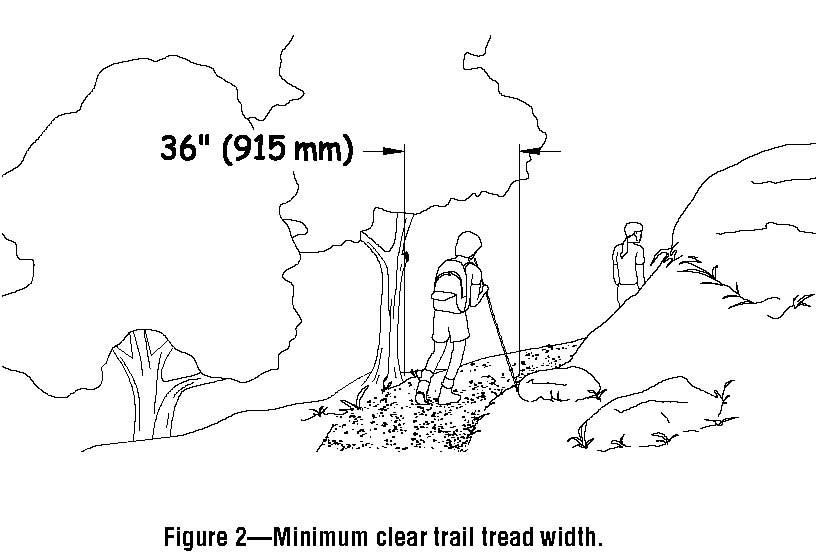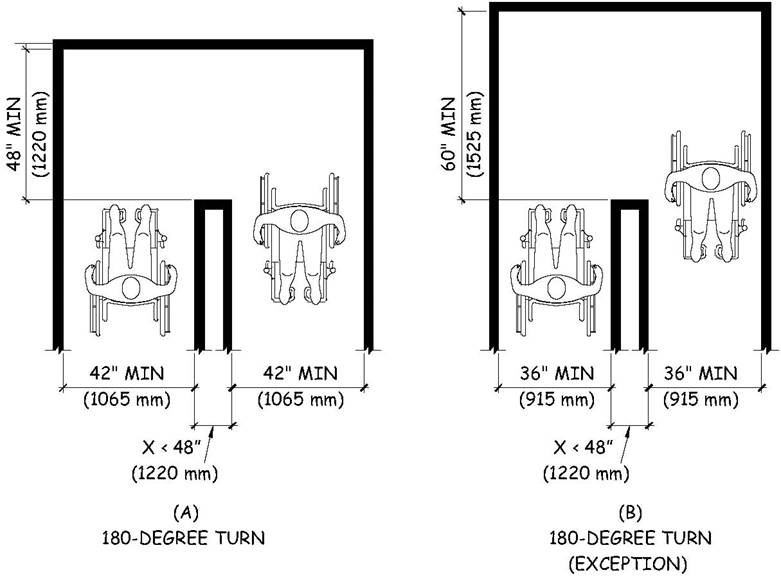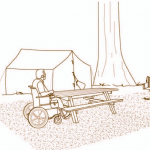Surface [1017.2]
The surfaces of trails, passing spaces, and resting intervals must be firm and stable. A stable trail surface is not permanently affected by expected weather conditions and can sustain normal wear and tear from the expected uses between planned maintenances.
Paving with concrete or asphalt may be appropriate for highly developed areas. For less developed areas, crushed stone, fine crusher rejects, packed soil, soil stabilizers, and other natural materials may provide a firm and stable surface. Natural materials also can be combined with synthetic bonding materials to provide greater stability and firmness. These materials may not be suitable for every trail.
Clear Tread Width [1017.3]
The clear tread width of trails must be a minimum of 36 inches (figure 2). The 36-inch-minimum clear tread width must be maintained for the entire distance of the trail and may not be reduced by gates, barriers, or other obstacles unless a condition for exception does not permit full compliance with the provision.
Where gates and barriers require users to make 90-degree or 180-degree turns, sufficient space should be provided for people using mobility devices to make the turns (figure 3). Mobility devices that are used in the outdoors typically have a longer wheel base and are wider than mobility devices that are used indoors.
Passing Spaces [1017.4]
A trail tread width less than 60 inches does not permit two people using mobility devices to pass each other. Consequently, where the tread width is less than 60 inches, passing spaces must be provided at intervals of at least 1000 feet. Where the trail is heavily used or the trail is not at the same level as the adjoining ground surface, such as a bridge crossing a ravine, increasing the frequency of passing spaces or widening the tread width to a minimum of 60 inches provides greater access. People using mobility devices also use passing spaces to turn around.
Where the full length of a trail does not fully comply with the trail technical requirements, a passing space must be located at the end of the trail segment that complies fully with the technical requirements. This enables people who use mobility devices to turn around and proceed back to where they started. Consider ways to alert people using mobility devices when a passing space provides the last opportunity on a trail to turn around, because this may not always be apparent. Printed materials, trail Web sites, trailhead information signs, and signage at the end of the trail segment that fully complies with the technical requirements could be used to indicate the location of the last place on the trail to turn around. Passing spaces must be a minimum of 60 by 60 inches (figure 4).
The intersection of two trails that provide a T-shaped space that complies with section 304.3.2 of the ABA Standards (figure 5), and the base and the arms of the T-shaped space extend a minimum of 48 inches beyond the intersection (figure 6).
Tread Obstacles [1017.5]
A tread obstacle is anything that interrupts the evenness of the tread surface. The vertical alignment of joints in concrete, asphalt, or board surfaces, as well as natural features, such as tree roots and rocks, within the trail tread can be tread obstacles. When the trail surface is constructed of concrete, asphalt, or boards, tread obstacles cannot exceed one-half inch in height at their highest point. When the trail surface is constructed of materials other than concrete, asphalt, or boards, tread obstacles are permitted to be a maximum of 2 inches high. Frequent tread obstacles and tread obstacles that cross the full width of a trail tread can make travel very difficult for people using mobility devices. Where possible, separate tread obstacles by at least 48 inches, particularly when the obstacles cross the entire tread width. This separation allows people using mobility devices to fully cross one obstacle before confronting another.
Openings [1017.6]
Openings are gaps in the surface of a trail. Gaps, including slots in a drainage grate and spaces between the planks on a bridge or boardwalk (figure 7), that are big enough for wheels, canes, or crutch tips to drop through or become trapped in are potential hazards. Openings in the surfaces of trails, passing spaces, and resting intervals must be small enough so that a sphere more than one-half inch in diameter cannot pass through. Where possible, elongated openings should be placed perpendicular, or as close to perpendicular as possible, to the dominant direction of travel.











